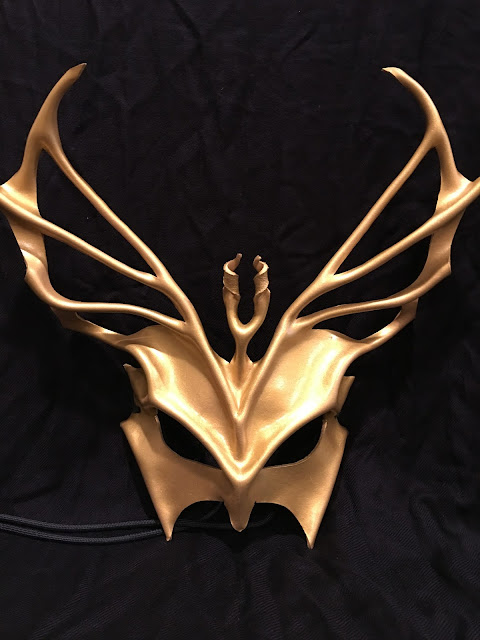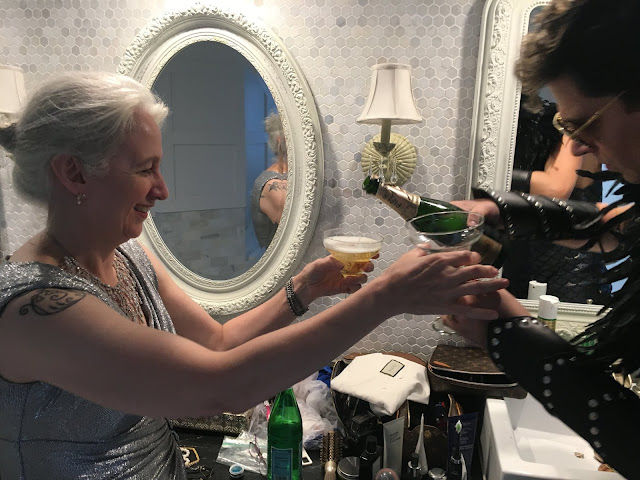Masks of Meaning
I gave a short talk the other day to the undergraduate majors in our department. It was one of seven “lightning” presentations that I and my departmental colleagues gave to demonstrate the variety of approaches and topics that the students might encounter in history as a discipline.
More of it has to do (again Johnstone) with our distrust of trance states (Johnstone was writing in 1979). In his words: “We distrust spontaneity, and try to replace it by reason: the Mask was driven out of theatre in the same way that improvisation was driven out of music.”
Thanks to Johnstone’s own teaching, improvisational theatre has made an enormous come-back over the past forty years, but Masks? Harder to say.
I think we are terrified of Masks for the same reason we are terrified of clowns. Masks rip away the pretensions that we have about being in control of the masks that we wear everyday. They destabilize what Goffman called our “presentation of self” and expose it as something not given, but made.
If I can change my character simply by putting on a physical mask, who am I but the mask that I wear?
One of us talked about the minting and iconography of medieval German coins. Another talked about the significance of the Underwriters Laboratory and its logo. Another spoke on the history of the British Empire and how there was no such thing as the “American revolution” (he said it three times!). Another described her discovery of tango music in the records of the former Soviet Union. Another told the story of Germany’s museums. Another showed us early 20th-century images of speech.
I talked about masks—and what they teach us about virtue. At least, that is what I wanted to talk about. But what I mainly wanted to do was show pictures of Milo.
Particularly this one.
Published, you might notice, in the campus newspaper, in an article about the zaniest (their word) professors on campus.
I could look at this picture all day.
The occasion was summer before last, when my friends and I from Three Kraters Symposium met together in real life for a toga-cum-surprise party—the surprise being Milo, who only a few knew was coming.
I wrote at the time about what it felt like, suddenly finding myself kneeling before Milo as if before a god. (He was dressed as Poseidon, I as Lady Wisdom. It was our balcony scene.) And about how our playacting was a form of allegory for putting on Christ.
You can see in the picture how glorious it was to be there in the moment, myself but not myself. Myself transformed through proximity to Milo, Milo in costume so as to be there with me.
Yes, he bought the outfit specially for the occasion. I have the trident now.
I also have the mask that Milo wore.
I have worn many masks over the course of my life. Right now I wear the masks of Professor Fulton Brown and Fencing Bear, but I have also worn the mask of Texan in Cambridge, England; Kentuckian in Amarillo; and Girl from Albuquerque in Louisville. Growing up, I put on a mask every time we moved. To this day, when people ask me where I’m from, I don’t know how to answer.
Everywhere.
Nowhere.
I do not belong.
A friend who shares the same personality type tells me that this sense of imposture is standard for INTJs. We are too aware of having to put on a public face in order to interact with others.
On the one hand, if we show too much of ourselves, we are convinced that people will run from us screaming. (Mind you, we aren’t complete idiots. We know what happens when people glimpse the messiness lurking under the smile.)
On the other hand, it leaves us feeling constantly alone.
Pretending feelings we don’t have so as to survive whatever social situation we find ourselves in, all the while desperate to escape back to our own thoughts.
Thoughts about patterns and meaning.
Thoughts about how all the layers of symbolism come together and collapse into significance.
Thoughts about the way in which putting on a character enables us to perform the magic of being out in public, even as we spend most of our time looking for clues about how everything fits together in the story.
Okay, maybe not all INTJs. But that pretty much describes my ordinary thought processes.
Put on mask.
Go out in public.
Smile.
Come home and try to figure out what just happened.
I’m betting Erving Goffman (“the most influential American sociologist of the twentieth century”) was an INTJ. How else could he understand so well the feeling that social interaction is a kind of performance?
He even talks about masks. Rather, in his most famous book The Presentation of Self in Everyday Life (1959), he quotes Robert Ezra Park talking about masks in order to substantiate his definition of person as a kind of mask. Here is Park:
It is probably no mere historical accident that the word person, in its first meaning, is a mask. It is rather a recognition of the fact that everyone is always and everywhere, more or less consciously, playing a role ... It is in these roles that we know ourselves.
In a sense, and in so far as this mask represents the conception we have formed of ourselves—the role we are striving to live up to—this mask is our truer self, the self we would like to be. In the end, our conception of our role becomes second nature and an integral part of our personality. We come into the world as individuals, achieve character, and become persons.Goffman notes that we may or may not believe the performance that we give. Sometimes it feels sincere. At other times it feels faked. But at no time (as Goffman would have it) are we not performing in some way. We wear the mask of our persona every time we interact with others.
But what happens when we put on somebody else’s mask? What happens when we consciously put on a mask that we know is not our own?
Milo and I talked about this mystery as we were getting dressed.
More specifically, I told him about an exercise that I had one of my classes do in order to help the students understand allegories like John Bunyan’s Pilgrim’s Progress (1678) as a form of spiritual exercise.
I got the exercise from a book that my husband told me about on improvisational theatre, where the purpose of the masks was to help actors develop new characters for the stage. The trick, as the director explained, was to “activate” the masks by having the actors glance at themselves in a mirror once they had put the mask on. Then they would act out whatever it was that the mask suggested they should.
Keith Johnstone, the author of the exercise, called it trance work and pointed to the similarities across religious cultures that use masks to encounter the divine. When I used the exercise in my course, I called it “putting on the face of Christ,” much as medieval Christians did when they imagined themselves responding to Christ with compassion as modeled by his mother Mary.
I also suggested it was what Bunyan intended his readers to do in putting themselves into the character Christian as he makes his way from the City of Destruction across the Slough of Despond through the Wicket Gate along the King’s Highway over the Hill of Difficulty through the Valley of the Shadow of Death to Vanity Fair where Faithful leaves him and he meets Hopeful; thence Hopeful and Christian make their way over the Delectable Mountains across the Enchanted Ground into the Land of Beulah and over the River of Death, at which they arrive at Mount Zion and the Celestial City, where they are welcomed into its heavenly bliss.
It sounds like nonsense, until you put the mask on.
“This is the face that goes with this mask,” Milo said as he looked at himself in the mirror. Johnstone explains that half-masks like Milo’s are incredibly powerful because they require the actor to fit his or her mouth to the mask. Full masks make the wearer feel safe, whereas half-masks have a more comic, mischievous feel. Appropriately for the role he intended to play (Lord of the Sea), Milo’s mask was at once terrifying and beautiful. Awe-inspiring. God-like.
His voice even changed as he adjusted his mouth.
It was exhilarating.
Tremendous.
You might even say, divine.
“A Mask,” says Johnstone, “is a device for driving the personality out of the body and allowing a spirit to take possession of it.” Almost as if the wearer becomes the Mask. Actors know that make-up can have similar effect.
Think of clowns.
Or the Joker.
And the frisson that you felt when you first saw him smile.
Johnstone again:
In its original culture nothing had more power than the Mask. It was used as an oracle, a judge, an arbitrator. Some were so sacred that any outsider who caught a glimpse of them was executed. They cured diseases, they made women sterile. Some tribes were so scared of their power that they carved the eye-holes so that the wearers could see only the ground.Our culture, Johnstone contends, is afraid of Masks for different reasons. Some of it (according to Johnstone) has to do with the Church—but note that it was the Puritans, not the Catholics, who wanted to have the Elizabethan theaters closed.
More of it has to do (again Johnstone) with our distrust of trance states (Johnstone was writing in 1979). In his words: “We distrust spontaneity, and try to replace it by reason: the Mask was driven out of theatre in the same way that improvisation was driven out of music.”
Thanks to Johnstone’s own teaching, improvisational theatre has made an enormous come-back over the past forty years, but Masks? Harder to say.
I think we are terrified of Masks for the same reason we are terrified of clowns. Masks rip away the pretensions that we have about being in control of the masks that we wear everyday. They destabilize what Goffman called our “presentation of self” and expose it as something not given, but made.
If I can change my character simply by putting on a physical mask, who am I but the mask that I wear?
But it goes deeper than this. Masks not only destabilize our social personae. They also call into question our existential personae, the sense that we have of inhabiting a merely secular world. Like Christian before he set out from the City of Destruction. Like the Joker (you’ve seen the new movie, right?), laughing in the midst of Gotham’s decay.
Masks—like Milo’s, like the face of Christ imprinted on Veronica’s veil—point us to the sacred, which is why they are so terrifying. It is also why children love—and hate them. They have not yet learned to fix their faces in the masks they will wear everyday.
They are still susceptible to the transformation.
They are still willing to become like God.
I have no idea how to translate into ordinary language how this process of divinization works. Paul hinted at it in 2 Corinthians 3:18, where he talked about being transformed “from glory to glory” into the image of the Lord which we (Christians) “behold as in a mirror,” now that the veil has been lifted from our own faces.
What I do know is that it would be zany indeed not to be willing to try.
For further reflections on the joys of wearing Milo’s mask, see The MILO Chronicles.










You look delicious. Who thought wisdom would be so tasty.
ReplyDelete